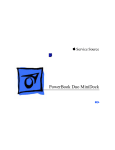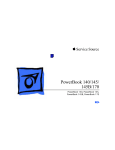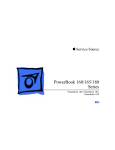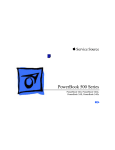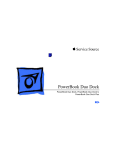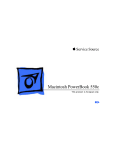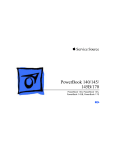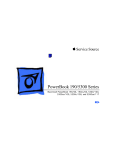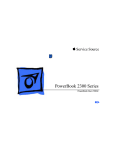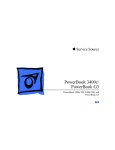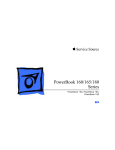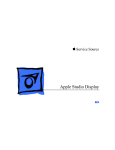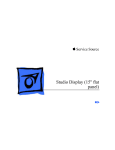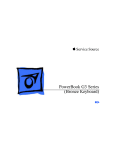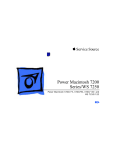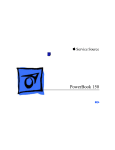Download Apple 165c Specifications
Transcript
K Service Source PowerBook 165c/180c PowerBook 165c, PowerBook 180c K Service Source Basics PowerBook 165c/180c Basics Overview - 1 Overview This manual includes complete repair procedures for the PowerBook 165C and PowerBook 180C, shown at left. Figure: PowerBook 165C, 180C Basics Repair Strategy - 2 Repair Strategy Service the PowerBook 165c and PowerBook180c through module exchange and parts replacement. Customers can request on-site service from an Apple Authorized Service Provider Plus (AASP+) Apple Assurance (US only), or request a courier through the Apple Canada Technical Answerline (Canada only). They can also choose carry-in service from an AASP. Ordering Apple Service Providers planning to support the computer systems covered in this manual may purchase Service modules and parts to develop servicing capability. To order parts, use the AppleOrder (US only) or ARIS (Canada only) system and refer to “Service Price Pages.” Basics Repair Strategy - 3 Large businesses, universities, and K-12 accounts must provide a purchase order on all transactions, including orders placed through the AppleOrder (US only) or ARIS (Canada only) system. USA Ordering US Service Providers not enrolled in AppleOrder may fax their orders to Service Provider Support (512-9088125) or mail them to Apple Computer, Inc. Service Provider Support MS 212-SPS Austin, TX 78714-9125 For US inquiries, please call Service Provider Support at 800-919-2775 and select option #1. Basics Repair Strategy - 4 Canadian Ordering Canadian Service Providers not enrolled in ARIS may fax their orders to Service Provider Support in Canada (1-800-903-5284). For Canadian inquiries, please call Service Provider Support at 905-513-5782 and select option #3. Basics Warranty/AppleCare/ARIS - 5 Warranty/AppleCare/ARIS US Only The PowerBook 165c and PowerBook180c are covered under the Apple One-Year Limited Warranty. The AppleCare Service Plan is also available for these products. Service Providers are reimbursed for warranty and AppleCare repairs made to these computers. For pricing information, refer to “Service Price Pages.” Canada Only The PowerBook 165c and PowerBook180c are covered under first-year AppleCare. The Extended AppleCare Service Plan is also available for these products. Service Providers are reimbursed for first-year warranty and Extended AppleCare repairs made to these computers. For pricing information, refer to “Service Price Pages.” Basics Display Compatibility Matrix - 6 Display Compatibility Matrix FSTN PowerBook 165c 661-0752 Active Matrix PowerBook 180c 661-0686 922-0373 922-0380 Inverter 922-0374 Inverter Cable 922-0566 Display Cable 922-0378 922-0412 Important: The PowerBook 165c/180c family includes two displays—an active matrix and an FSTN display. Each of these displays requires a compatible inverter and display cable; the inverters, display cables, and displays are not interchangeable. Before ordering one of these parts, refer to the display matrix shown above. K Service Source Specifications PowerBook 165c/180c Specifications Introduction - 2 Introduction Specifications information for this product can be found in this chapter and also in the Spec Database, which you can access in one of three ways: • Launch it directly by double-clicking the Apple Spec Database runtime alias at the top level of the Main Service Source CD. • Select “Apple Spec Database” from the Service Source dropdown main menu. • Click the Acrobat toolbar icon for the database, which is near the right end of the toolbar with the letters “SP.” Specifications Configurations - 3 Configurations Standard 165c Standard 180c Options 4 MB PSRAM, FSTN color display, 80/120 MB hard drive, 1.4 MB Apple SuperDrive, NiCad battery, AC adapter, and microphone 4 MB PSRAM, 8.4 in (226 mm) diagonal backlit color activematrix LCD display, 80 or 160 MB hard drive, 1.4 MB Apple SuperDrive, NiCad battery, AC adapter, and microphone Internal PowerBook Express Modem (14,400 bps) Internal PowerBook Fax/Data Modem (2400 bps) 4 MB memory expansion kit PowerBook battery recharger HDI-30 SCSI system cable HDI-30 SCSI disk adapter Specifications Processor - 4 Processor CPU Motorola 68030 microprocessor 33 MHz Coprocessor Motorola 68882 floating-point math coprocessor 33 MHz Addressing 32-bit internal registers 32-bit address bus 32-bit data bus Specifications Memory - 5 Memory RAM 4 MB pseudostatic RAM (PSRAM) Expandable to 8 MB by adding 4 MB expansion card Expandable to 14 MB with third-party PSRAM expansion cards Requires 85 ns or faster RAM chips ROM 1 MB PRAM 256 bytes of parameter memory Specifications Memory - 6 VRAM 512K of video RAM supports internal display and external monitor Clock/Calendar CMOS custom chip with long-life lithium battery Specifications Disk Storage - 7 Disk Storage Floppy Drive 19 mm high, internal, 1.4 MB Apple SuperDrive Hard Drive 2.5 in. SCSI hard drives (many capacities) Specifications I/O Interfaces - 8 I/O Interfaces Apple Desktop Bus ADB port (maximum of three ADB devices is recommended) 200 mA maximum current draw for all ADB devices Serial Two RS-422 serial ports; mini DIN-8 connectors SCSI HDI-30 SCSI port with 1.5 MB/sec. transfer rate Connect SCSI device to computer with HDI-30 SCSI system cable. Sound Monaural sound-in port; adapters required to input sound from audio equipment with line level outputs (line level signals must be attenuated 500:1) Stereo sound-out jack for headphones or external audio amplifier Specifications Video I/O Interfaces - 9 Video-out port; 8 bit, 256 color video support Micro DB-15 connector Supports most Macintosh monitors, VGA and SVGA monitors Power Adapter Power adapter port Modem Slot for optional internal modem Security Slot for third-party security equipment Specifications I/O Devices - 10 I/O Devices Keyboard Built-in keyboard with standard Macintosh layout 63 keys domestic; 64 keys ISO 3.0 mm travel; 18 mm vertical pitch, 18.63 mm horizontal pitch Two-level tilt adjustment Trackball 30 mm diameter, dual button Apple Desktop Bus (ADB) interface Microphone Electret, omnidirectional Output voltage of 4 mV, peak to peak Specifications Sound and Video - 11 Sound and Video Sound Generator PowerBook 165c Video Display PowerBook 180c Video Display Apple sound chip provides 4-voice, 8-bit sound 8-bit sound input, sampled at 11 or 22 kHz 9 in. (230 mm) diagonal screen Flat-panel, color, film-compensated supertwist nematic (FSTN) liquid crystal display CCFL on-demand backlight 640 lines by 400 pixels; 8 bit; 256 colors 8.4 in. (215 mm) diagonal screen Flat-panel, color, active-matrix, liquid crystal display CCFL on-demand backlight 640 lines by 480 pixels; 8 bit; 256 colors Specifications Electrical - 12 Electrical Main Battery Rechargeable nickel cadmium (NiCad) battery Provides 1.5–2 hours of usage before recharging PRAM Battery 3 V, 30 mAh rechargeable lithium battery Power Adapter 110–240 VAC line voltage 24 W, 50–60 Hz US, United Kingdom, Australian, and European versions Specifications Physical - 13 Physical PowerBook 165c PowerBook 180c Height: 2.29 in. (58 mm) Width: 11.26 in. (286 mm) Depth: 9.29 in. (236 mm) Weight: 7.0 lb. (3.18 kg) with battery Height: 2.34 in. (59 mm) Width: 11.25 in. (286 mm) Depth: 9.3 in. (236 mm) Weight: 7.1 lb. (3.2 kg) with battery Specifications Environmental - 14 Environmental Operating Temperature Storage Temperature 50–104° F (10–40° C) -13 to 140° F (-25 to 60° C) Relative Humidity 20–80% noncondensing Shipping Altitude 0–15,000 ft. (0–4722 m) Operational Altitude 0–10,000 ft. (0–3048 m) Specifications Other - 15 Other Fax/Data Modem Internal 2400-baud modem with fax send at 9600 baud (includes fax send software) 300/1200/2400 bps transmission rates Serial binary and asynchronous protocols Error correction and data compression: MNP 4, 5 and V.42, V.42bis Specifications Express Modem SCSI Disk Adapter Other - 16 Internal 14,400-baud modem with fax send and receive capability at 9600 baud 300 to 14,400 bps data transmission rates 2400/4800/7200/9600 bps fax transmission rates Full duplex operation; asynchronous or framed modes Error correction: V.42 compliance (MNP 2-4) Data compression: V.42 bis (4 to 1 compression) and MNP-5 (2 to 1 compression) Requires 300K of system RAM Enables connection between PowerBook computer and desktop Macintosh (PowerBook appears as a hard drive on the desktop) K Service Source Troubleshooting PowerBook 165c/180c Troubleshooting General/ - 1 General The Symptom Charts included in this chapter will help you diagnose specific symptoms related to your product. Because cures are listed on the charts in the order of most likely solution, try the first cure first. Verify whether or not the product continues to exhibit the symptom. If the symptom persists, try the next cure. (Note: If you have replaced a module, reinstall the original module before you proceed to the next cure.) If you are not sure what the problem is, or if the Symptom Charts do not resolve the problem, refer to the Flowchart for the product family. For additional assistance, contact Apple Technical Support. Troubleshooting Symptom Charts/Startup - 2 Symptom Charts Startup RAM failure occurs (eight-tone error chord sequence sounds after startup chord) 1 2 3 4 Reseat PSRAM expansion card and check connection. Replace PSRAM expansion card. Replace daughterboard. Replace motherboard. Hardware failure occurs (four-tone error chord sequence sounds after startup chord) 1 Disconnect hard drive data cable and restart computer. If startup sequence is normal, reconnect cable and retest. Replace hard drive. Disconnect floppy drive cable and restart computer. If startup sequence is normal, reconnect cable and retest. Replace floppy drive. Replace motherboard. 2 3 4 5 Troubleshooting Symptom Charts/Startup - 3 Startup Screen displays checkerboard pattern; no startup chime 1 2 3 4 Reseat RAM expansion card. Replace RAM expansion card. Replace daughterboard. Reseat display cable. Troubleshooting Symptom Charts/Power - 4 Power Screen is blank; computer doesn’t respond 1 2 3 4 Restart computer. Connect power adapter and restart computer in 3–4 minutes. Try known-good, charged main battery. Check all interconnect board, daughterboard, and motherboard connections. 5 Reset the power manager. 6 Replace keyboard. 7 Replace interconnect board. 8 Replace daughterboard. 9 Replace motherboard. 10 PowerBook165c: Replace display. 11 PowerBook180c: Replace display (CPRC/international repairers only). Troubleshooting Symptom Charts/Power - 5 Power After you remove main battery, some Control Panel settings are different 1 2 3 4 Check cables. Replace interconnect board. Replace daughterboard. Replace motherboard. Power adapter is plugged in, but battery DA does not indicate charger is connected 1 2 3 4 5 6 This is normal for fully charged battery. Check battery charger connection. Try known-good, charged main battery. Try known-good power adapter. Check battery thermistor cable connection. Replace motherboard. Troubleshooting Symptom Charts/Power - 6 Power Low-power warning appears 1 2 3 4 5 6 7 Computer runs when plugged into wall outlet but not on battery power; battery voltage is within tolerance 1 2 3 4 Recharge battery or attach power adapter. Verify that peripherals are low-power. PowerBook 165c: Remove external devices or connect power adapter. PowerBook 180c: Remove external devices. Try known-good, charged main battery. Try known-good power adapter. Replace motherboard. Reseat battery to make sure it is mating with contacts on motherboard. If motherboard includes removable fuse, replace fuse. Replace motherboard. Return computer to Apple. Troubleshooting Symptom Charts/Power - 7 Power Computer won’t start with battery removed or with depleted battery 1 2 3 Make sure AC adapter is 24-watt. Make sure battery is charged. Replace AC adapter. The 180c powers on, then powers off when screen lights up 1 Make sure AC adapter is 24-watt. (“24W” should be imprinted on the adapter. Or, check the model number, which should be M5652). If it’s not a 24-watt adapter, replace it Troubleshooting Symptom Charts/Video - 8 Video Row or partial row of pixels never comes on or is always on PowerBook 165c: 1 2 3 4 Check cables. Replace display cable. Replace display. Replace interconnect board. PowerBook 180c: 5 6 7 8 Check cables. Replace display cable. Replace interconnect board. Replace display (CPRC/international repairers only). Troubleshooting Symptom Charts/Video - 9 Video Thin white line is always on at middle of screen PowerBook 165c: Thin white line is normal. PowerBook 180c: Replace display (CPRC/international repairers only) or return computer to Apple. Troubleshooting Symptom Charts/Video - 10 Video Display is very light or totally white 1 2 3 4 5 6 7 8 PowerBook 165c: Adjust screen contrast. Check display cable, converter, inverter, interconnect board, daughterboard, and motherboard connections. Replace converter board. PowerBook 180c: Replace inverter board. Replace interconnect board. Replace display cable. PowerBook 165c: Replace display. PowerBook 180c: Replace display (CPRC/international repairers only). Troubleshooting Symptom Charts/Video - 11 Video No display, but computer appears to operate correctly 1 2 3 4 5 6 7 8 9 10 11 12 13 PowerBook 165c: Adjust screen contrast and backlight intensity. PowerBook 180c: Adjust backlight intensity. Check display cable, converter, inverter, interconnect board, daughterboard, and motherboard connections. Connect power adapter. Replace converter board. PowerBook 180c: Replace inverter board. Replace interconnect board. Replace converter-to-inverter cable. Replace display cable. PowerBook 165c: Replace display. PowerBook 180c: Replace display (CPRC/international repairers only). Replace daughterboard. Replace motherboard. Troubleshooting Symptom Charts/Video - 12 Video Rainbow colors visible from extreme viewing angles PowerBook 165c: Screen brightness is not uniform PowerBook 165c: Such colors are normal for FSTN screens. Irregularity in screen brightness is normal. Adjust contrast and brightness to diminish effect. PowerBook 180c: Replace display (CPRC/international repairers only). Troubleshooting Symptom Charts/Video - 13 Video Display stopped working or dimmed but is fine now PowerBook 165c: If temperature is in the approximate range of under 5 or over 40 degrees centigrade, this reaction is normal. Troubleshooting Symptom Charts/Video - 14 Video Backlight doesn’t operate 1 2 Verify that cables are not pinched or severed. Check display cable, converter, inverter, interconnect board, daughterboard, and motherboard connections. 3 Replace converter board. 4 PowerBook 180c: Replace inverter board. 5 Replace converter-to-inverter cable. 6 Replace interconnect board. 7 PowerBook 165c: Replace display. 8 Replace daughterboard. 9 Replace motherboard. 10 PowerBook 180c: Replace display (CPRC/international repairers only). Troubleshooting Symptom Charts/Video - 15 Video Screen goes blank 1 2 3 4 Press any key to wake computer from system sleep. Check display cable connection. Reseat daughterboard. Replace daughterboard. Troubleshooting Symptom Charts/Video - 16 Video Pixel is always white or always black PowerBook 180c: In general, no display should be replaced because of subpixel irregularities. If the number of irregularities on a display appears excessive, contact Apple for more information. Note: Each pixel on an active-matrix color display consists of three subpixels (red, green, and blue). In turn, each subpixel has a transistor that controls light transmission. A PowerBook 180c display, therefore, contains a total of 921,000 transistors (640 x 480 x 3). Due to technology constraints, subpixel transistor irregularities (red, green, blue, black, and white) are allowed in this display. PowerBook 165c: replace display. Troubleshooting Symptom Charts/Floppy Drive - 17 Floppy Drive Audio and video present, but internal floppy drive does not operate 1 2 3 4 5 6 Try known-good floppy disk. Check floppy drive cable connection. Replace floppy drive cable. Replace floppy drive. Replace daughterboard. Replace motherboard. Disk ejects while booting; display shows Macintosh icon with blinking X 1 2 3 4 5 6 Try known-good system disk. Verify that trackball or mouse button is not stuck. Check floppy drive cable connection. Replace floppy drive cable. Replace floppy drive. Replace motherboard. Troubleshooting Symptom Charts/Floppy Drive - 18 Floppy Drive Disk does not eject Disk initialization fails 1 2 3 4 5 6 7 Switch off system and hold mouse button down while you switch system on. Insert opened paper clip into hole beside drive. Check floppy drive cable connection. Replace floppy drive cable. Replace floppy drive. Replace daughterboard. Replace motherboard. 1 2 3 4 5 Try known-good floppy disk. Install inverter shield (if absent). Check floppy drive cable connection. Replace floppy drive cable. Replace floppy drive. Troubleshooting Symptom Charts/Floppy Drive - 19 Floppy Drive Read/write/copy error 1 2 3 4 5 Try known-good floppy disk. Install inverter shield if absent. Check floppy drive cable connection. Replace floppy drive cable. Replace floppy drive. Troubleshooting Symptom Charts/Hard Drive - 20 Hard Drive Internal hard drive does not operate 1 2 3 4 5 6 Disconnect external SCSI devices. Check internal hard drive cable connection. Use HD SC Setup to reinitialize drive. Replace internal hard drive cable. Replace internal hard drive. Replace motherboard. Troubleshooting Symptom Charts/Peripheral - 21 Peripheral After you connect external SCSI device, computer does not boot 1 2 3 4 5 6 7 Switch on external SCSI device before starting computer. Check cable connections. Verify that standard Apple terminator terminates SCSI chain at beginning and end. Verify that SCSI select switch setting on external device is unique. Verify operation of internal hard drive. Try known-good external SCSI device. Replace motherboard. Troubleshooting Symptom Charts/Peripheral - 22 Peripheral Cursor does not move when you are using trackball 1 2 3 5 6 7 Restart computer. Check cables. Check interconnect board, daughterboard, and motherboard connections. Try low-power mouse. If cursor moves, replace trackball or keyboard. Replace interconnect board. Replace daughterboard. Replace motherboard. 1 2 3 4 5 6 Restart computer. Check cables. Replace trackball. Replace keyboard. Replace interconnect board. Replace motherboard. 4 Cursor intermittently does not move or moves erratically Troubleshooting Symptom Charts/Peripheral - 23 Peripheral Cursor moves, but clicking trackball button has no effect 1 2 3 4 5 6 7 Restart computer. Check interconnect board, daughterboard, and motherboard connections. Replace trackball. Replace keyboard. Replace interconnect board. Replace daughterboard. Replace motherboard. Cursor does not move when you are using mouse 1 2 3 4 5 Check mouse connection to ADB port. Restart computer. Clean mouse ball and inside mouse. Replace mouse. Replace motherboard. Troubleshooting Symptom Charts/Peripheral - 24 Peripheral No response to any key on keyboard Known-good directconnect printer does not print 1 3 4 5 Reset power manager. (Unplug power adapter, shut down computer, wait, and then restart computer.) Check connections of keyboard to interconnect board, and interconnect board to daughterboard. Replace keyboard. Replace interconnect board. Replace daughterboard. 1 2 3 4 5 6 7 Verify that System is 7.1 or later. Verify that Chooser and Control Panel settings are correct. Check cables. Replace printer interface cable. Try known-good printer. Replace daughterboard. Replace motherboard. 2 Troubleshooting Symptom Charts/Peripheral - 25 Peripheral Known-good network printer does not print Device connected to external modem port doesn’t work 1 2 3 4 5 6 7 Verify that System is 7.1 or later. Verify that Chooser and Control Panel settings are correct. Check cables. Replace printer interface cable. Try known-good printer. If printer works, troubleshoot network. Replace daughterboard. Replace motherboard. 1 2 3 4 5 6 Verify that External Modem is selected in CDEV. Verify that System is 7.1 or later. Check cables. Test device with known-good computer. Replace daughterboard. Replace motherboard. Troubleshooting Symptom Charts/Peripheral - 26 Peripheral I/O devices are unrecognized or garbage is transmitted or received 1 2 3 4 5 6 7 Verify that System is 7.1 or later. Check cables. Verify that SCSI device has standard Apple terminator. Verify that SCSI select switch setting on external device is unique. Test device with known-good computer. Replace daughterboard. Replace motherboard. Troubleshooting Symptom Charts/Internal Modem - 27 Internal Modem Internal modem options do not appear in CDEV 1 2 3 4 Remove and reseat modem card. Verify that System is 7.1 or later. Replace modem card. Replace motherboard. Modem does not respond properly to AT command set instructions 1 Verify that baud rate and data format settings of communications application are compatible with internal modem and remote modem. Check phone cord connection and operation. Remove and reseat modem card. Verify that System is 7.1 or later. Replace modem card. 2 3 4 5 Troubleshooting Symptom Charts/Internal Modem - 28 Internal Modem Strange mix of characters appears on screen 1 2 3 4 5 6 7 Verify that baud rate and data format settings of communications application are compatible with internal modem and remote modem. Check phone cord connection and operation. Remove and reseat modem card. Verify that System is 7.1 or later. Replace modem card. Replace daughterboard. Replace motherboard. Modem interferes with system sound 1 2 3 4 Remove and reseat modem card. Replace modem board. Replace interconnect card. Replace motherboard. Troubleshooting Symptom Charts/Internal Modem - 29 Internal Modem Modem does not respond to incoming call 1 2 3 4 If computer is in sleep mode, verify that Wake On Ring option in CDEV is selected. Check phone cord connection and operation. Replace modem card. Replace motherboard. Modem has no sound output 1 2 3 4 Verify that Control Panel volume setting is above 0. Replace modem card. Replace interconnect card. Replace motherboard. Modem connects but does not communicate with remote modem 1 Verify that remote modem needs error correction (error correction is internal modem default). Type AT &Q0 to disable error correction. 2 Troubleshooting Symptom Charts/Miscellaneous - 30 Miscellaneous Screen goes blank and computer shuts down every few minutes Adjust sleep delays in Control Panel or connect power adapter. Application seems to run slower after few seconds 1 2 Hard drive is slow to respond, or screen goes blank too often Adjust sleep delays in Control Panel or connect power adapter. Disable System Rest. (See owner’s manual.) Connect power adapter. Troubleshooting Symptom Charts/Miscellaneous - 31 Miscellaneous No sound from speaker 1 2 3 4 5 6 Verify that volume setting in Control Panel is above 0. Verify that no external speaker is plugged in. Check connections of speaker to interconnect board, interconnect board to daughterboard, and daughterboard to motherboard. Replace interconnect board. Replace daughterboard. Replace motherboard. Troubleshooting PowerBook 165c/180c Startup Problems Flowchart/ PowerBook 165c/180c Startup Problems Flowchart START Reset the power manager. Press the power button to begin the startup sequence. Do the startup tones sound? Does any video appear? No 1. 2. 3. 4. No Yes Does a gray pattern appear? Yes 1 1. Replace the daughterboard. 2. Replace the motherboard. Yes Yes Is the startup tone normal? No No Check the cables. Replace the interconnect board. Replace the daughterboard. Replace the motherboard. See Startup Problems in the Symptom/Cure Chart. 1. 2. 3. 4. Check the cables. Replace the inverter board. Replace the interconnect board. Replace the display cable. PowerBook 520, 520c, 540, 540c: Replace the interconnectto-display cable. 5. Replace the display. PowerBook 170, 180, 180c: Replace the display (international only) or return the computer to Apple. 6. Replace the daughterboard. 7. Replace the motherboard. Troubleshooting PowerBook 165c/180c Startup Problems Flowchart/ PowerBook 165c/180c Startup Problems Flowchart (continued) Go to Start 1 Does the desktop appear? Does the disk icon with the flashing question mark remain on the screen? No Yes 1. Replace the daughterboard. 2. Replace the motherboard. Yes 1. 2. 3. 4. 5. 6. 7. Do the trackball and keyboard function? No No Yes Reset parameter RAM. Use HD SC Setup to update the SCSI driver. Reinstall System Software. Replace the internal hard drive cable. Replace the hard drive. Replace the motherboard. Replace the daughterboard. 1. Reset the power manager. 2. Check the cables. 3. Replace the trackball (or trackpad). 4. Replace the keyboard. 5. Replace the interconnect board. 6. Replace the daughterboard. 7. Replace the motherboard. Insert a known-good disk into the floppy disk drive and try to initialize it. Does the disk initialize? Yes END No 1. Replace the floppy drive cable. 2. Replace the floppy drive. K Service Source Take Apart PowerBook 165c/180c Take Apart Main Battery - 1 Main Battery Before you begin, disconnect the power adapter. Note: This procedure also covers removal of the main battery door. Important: Before removing the main battery, use the Macintosh Shut Down command. Main Battery Take Apart Main Battery - 2 The main battery contains toxic materials. Review battery handling and disposal instructions in Bulletins/ Safety. ±Warning: 1 2 Slide open the battery door. Using the battery door as a handle, pull out the main battery. Take Apart Main Battery - 3 3 4 End Tab Slide the battery door completely open. Pull the end tab until it releases, and remove the door from the battery. Take Apart I/O Door - 4 I/O Door No preliminary steps are required before you begin this procedure. Caution: The PowerBook 165c/180c contains CMOS devices that are very susceptible to ESD damage. Review the ESD precautions in Bulletins/Safety. I/O Door Take Apart I/O Door - 5 1 2 Peg Open the I/O door. Carefully bend the door so that the middle bows downward and unhinge the two pegs located at the bottom corners. Take Apart Top Case - 6 Top Case Before you begin, remove the following: • Main battery • I/O door Top Case Caution: The PowerBook 165c/180c contains CMOS devices that are very susceptible to ESD damage. Review the ESD precautions in Bulletins/Safety. Take Apart Top Case - 7 1 Note: Use a T-8 Torx driver to remove the small screw from the rear connector panel and a T-10 Torx driver to remove the other case screws. Remove the five Torx screws from the bottom case. Take Apart Top Case - 8 2 3 Interconnect Cable Lift the back of the top case and disconnect the interconnect cable. Lift off the top case and unhook the two tab fasteners from the front of the bottom case. Replacement Caution: When connecting the interconnect cable connector, fold the cable as shown. If it is not folded correctly, the cable could short. Tab Fastener Take Apart Trackball Assembly - 9 Trackball Assembly Trackball Assembly Before you begin, remove the following: • Main battery • I/O door • Top case Caution: The PowerBook 165c/180c contains CMOS devices that are very susceptible to ESD damage. Review the ESD precautions in Bulletins/Safety. Take Apart Trackball Assembly - 10 1 Trackball Ribbon Cable Locking Tab Caution: The trackball ribbon cable is fragile and should be handled with care. Pull out the locking tab on the trackball connector and disconnect the trackball ribbon cable. Take Apart Trackball Assembly - 11 2 Using a T-8 Torx driver, remove the two mounting screws and lift the trackball assembly from the top case. Take Apart Keyboard - 12 Keyboard Keyboard Before you begin, remove the following: • Main battery • I/O door • Top case • Trackball assembly Caution: The PowerBook 165c/180c contains CMOS devices that are very susceptible to ESD damage. Review the ESD precautions in Bulletins/Safety. Take Apart Keyboard - 13 1 Keyboard Ribbon Cables Caution: The keyboard ribbon cables are fragile and should be handled with care. Lift the locking tabs on the two keyboard connectors and disconnect the keyboard ribbon cables. Take Apart Keyboard - 14 2 Using a T-8 Torx driver, remove the seven mounting screws and lift the keyboard from the top case. Take Apart DC/DC Converter - 15 DC/DC Converter Before you begin, remove the following: • Main battery • I/O door • Top case DC/DC Converter Caution: The PowerBook 165c/180c contains CMOS devices that are very susceptible to ESD damage. Review the ESD precautions in Bulletins/Safety. Take Apart DC/DC Converter - 16 1 2 Shield DC/DC Converter Converter-toInverter Cable 3 Remove the two mounting screws. Note: Do not remove the shield from the DC/DC converter. Pull the DC/DC converter and attached shield straight up and off the connector on the interconnect board. Disconnect the converter-to-inverter cable. Take Apart Brightness Pot DC/DC Converter - 17 Contrast Pot PowerBook 165c DC/DC Converter Actuator Actuator Replacement Note: Be sure to align the brightness and contrast pots on the DC/DC converter with the plastic actuators on the top case. It is easiest to align the pots and actuators if you set both to their extreme outer positions. Take Apart DC/DC Converter - 18 Brightness Pot PowerBook 180c DC/DC Converter Actuator Replacement Note: Be sure to align the brightness pot on the DC/DC converter with the plastic actuator on the top case. It is easiest to align the pot and actuator if you set both to their extreme outer positions. Take Apart DC/DC Converter - 19 Shield DC/DC Converter Replacement Note: If you are replacing the DC/DC converter, order both the converter and its shield (part number 922-0418). Install the new shield on the converter before replacing it. Do not reuse the original shield. Take Apart Interconnect Board - 20 Interconnect Board Before you begin, remove the following: • Main battery • I/O door • Top case • DC/DC converter Caution: The PowerBook 165c/180c contains CMOS devices that are very susceptible to ESD damage. Review the ESD precautions in Bulletins/Safety. Interconnect Board Take Apart Interconnect Board - 21 The interconnect board contains hazardous materials. Return bad interconnect boards to Apple for proper disposal. ±Warning: J5 Connector 1 J3 Connector Caution: The keyboard and display cables are fragile and should be handled with care. Lift the locking tabs on connectors J5 and J3 and disconnect the keyboard ribbon cables. Take Apart Interconnect Board - 22 2 Note: The display cable will not come entirely out of the connector until you remove the interconnect board from the top case. Pull out the locking tab on connector J2 and ease the display cable out of the connector as far as the cable will go. J2 Connector Replacement Note: Connect the display cable before replacing the interconnect board. Take Apart Interconnect Board - 23 3 Using a T-8 Torx driver, remove the two mounting screws and lift the interconnect board from the top case. Take Apart Actuators - 24 Actuators Actuators Before you begin, remove the following: • Main battery • I/O door • Top case • DC/DC converter Caution: The PowerBook 165c/180c contains CMOS devices that are very susceptible to ESD damage. Review the ESD precautions in Bulletins/Safety. Take Apart Actuators - 25 Replacement Note: The PowerBook 180c has only one brightness actuator. 1 2 Pull up the contrast actuator, rotate it toward the display, and remove the actuator from the top case. Repeat for the brightness actuator. Take Apart Elevation Foot - 26 Elevation Foot Before you begin, remove the following: • Main battery • I/O door • Top case Elevation Foot Elevation Foot Caution: The PowerBook 165c/180c contains CMOS devices that are very susceptible to ESD damage. Review the ESD precautions in Bulletins/Safety. Take Apart Elevation Foot - 27 1 2 Spring Clip Elevation Foot Using a T-8 Torx driver, remove the Torx screw, washer, and spring clip from the inside of the elevation foot. Pull off the elevation foot. Take Apart Cousin Card - 28 Cousin Card Before you begin, remove the following: • Main battery • I/O door • Top case • PSRAM expansion card (if present) Caution: The PowerBook 165c/180c contains CMOS devices that are very susceptible to ESD damage. Review the ESD precautions in Bulletins/Safety. Cousin Card Take Apart Cousin Card Daughterboard Logic Board Take-Apart Tool Cousin Card - 29 Caution: Always use the logic board take-apart tool to separate the cousin card connector from the daughterboard connector. Trying to disconnect the cousin card from the daughterboard by rocking or peeling the boards apart damages the connectors. Using the Apple logic board take-apart tool, disconnect the cousin card from the daughterboard. Take Apart Daughterboard - 30 Daughterboard Before you begin, remove the following: • Main battery • I/O door • Top case • PSRAM expansion card (if present) • Cousin card Caution: The PowerBook 165c/180c contains CMOS devices that are very susceptible to ESD damage. Review the ESD precautions in Bulletins/Safety. Daughterboard Take Apart Daughterboard - 31 Daughterboard 1 Motherboard 2 Logic Board Take-Apart Tool Using a T-8 Torx driver, remove the four daughterboard mounting screws. Caution: Always use the logic board take-apart tool to separate the daughterboard connector from the motherboard connector. Trying to disconnect the daughterboard from the motherboard by rocking or peeling the boards apart damages the connectors. Take Apart Daughterboard - 32 Heat Sinks Using the Apple logic board take-apart tool, disconnect the daughterboard from the motherboard. Replacement Note: The green heat sinks attached to the daughterboard are made of delicate heat-conducting material. If they are missing or damaged, they must be replaced. Daughterboard Replacement Note: To replace a damaged heat sink, carefully peel it from the daughterboard. Select the Take Apart Daughterboard - 33 appropriately sized heat sink from the heat sink kit (part number 076-0069), and gently press the part into place. Replacement Caution: Make sure the heat sink is placed exactly as shown in the illustration. The heat sink should not hang over the side of the component it is covering, or it may short the component leads. Take Apart Motherboard - 34 Motherboard Before you begin, remove the following: • Main battery • I/O door • Top case • PSRAM expansion card (if present) • Cousin card • Daughterboard • Modem card (if present) Caution: The PowerBook 165c/180c contains CMOS devices that are very susceptible to ESD damage. Motherboard Take Apart Motherboard - 35 Hard Drive Cable Floppy Drive Cable Review the ESD precautions in Bulletins/Safety. Caution: The hard drive, floppy drive, and thermistor cables are fragile and should be handled with care. Thermistor Cable 1 Locking Tab Locking Tab 2 Lift the locking tabs and disconnect the floppy drive and thermistor cables. Remove the hard drive cable. Take Apart Motherboard - 36 Hex-Head Screw Motherboard 3 Remove the two hexhead screws and lift the motherboard from the bottom case. Take Apart Motherboard - 37 Sound Jack Insulator Sound Jack Assembly Motherboard Replacement Note: To replace the insulator on the sound jack assembly, carefully peel off the original insulator. Remove the paper backing on the replacement insulator, and gently press it into place. Replacement Caution: Make sure the replacement insulator sits in exactly the same position as the original insulator. Take Apart Hard Drive - 38 Hard Drive Before you begin, remove the following: • Main battery • I/O door • Top case • Modem card (if present) • PSRAM expansion card (if present) • Cousin card • Daughterboard Hard Drive Caution: The PowerBook 165c/180c contains CMOS devices that are very susceptible to ESD damage. Take Apart Hard Drive - 39 Review the ESD precautions in Bulletins/Safety. Hard Drive Cable 1 Caution: The hard drive cable is fragile and should be handled with care. Disconnect the hard drive cable from the motherboard. Take Apart Hard Drive - 40 2 Retainer Latch 3 Drive Retainer Using a T-8 Torx driver, remove the five screws from the drive retainer. Using a jeweler’s screwdriver, release the drive retainer latch and remove the retainer. Take Apart Hard Drive - 41 4 5 Release Loop Lift the hard drive from the case. Pull the release loop and disconnect the hard drive cable. Note: If the cable does not have a release loop, gently pry the cable from the drive with a screwdriver. Replacement Note: For information on returning drives, cables, and carriers to Apple, refer to the Hard Drives manual. Take Apart Floppy Drive - 42 Floppy Drive Floppy Drive Before you begin, remove the following: • Main battery • I/O door • Top case • Modem card (if present) • PSRAM expansion card (if present) • Cousin card • Daughterboard Caution: The PowerBook 165c/180c contains CMOS devices that are very susceptible to ESD damage. Take Apart Floppy Drive - 43 Review the ESD precautions in Bulletins/Safety. Floppy Drive Cable Locking Tab 1 Caution: The floppy drive cable is fragile and should be handled with care. Lift the locking tab and disconnect the floppy drive cable from the motherboard. Take Apart Floppy Drive - 44 2 Retainer Latch 3 Drive Retainer Using a T-8 Torx driver, remove the five Torx screws from the drive retainer. Using a jeweler’s screwdriver, release the drive retainer latch and remove the retainer. Take Apart Floppy Drive - 45 4 Locking Tab 5 Slide the floppy drive back and lift it from the bottom case. Using a jeweler’s screwdriver, push out the locking tab and disconnect the floppy drive cable from the drive. Replacement Caution: When connecting the floppy drive cable connector, fold the cable as shown. If it is not folded correctly, the cable could short. Take Apart Floppy Drive - 46 PowerBook 165c Floppy Drive Heat Sink Insulator Replacement Note: The insulator for the floppy drive heat sink is a transparent mylar sheet attached to the underside of the keyboard. To replace the insulator, carefully peel off the original insulator. Remove the paper backing on the replacement insulator, and gently press it into place. Take Apart Floppy Drive - 47 Replacement Caution: Make sure the replacement insulator sits in exactly the same position as the original insulator. Take Apart Display Bezel - 48 Display Bezel Display Bezel Before you begin, remove the main battery. Caution: The PowerBook 165c/180c contains CMOS devices that are very susceptible to ESD damage. Review the ESD precautions in Bulletins/Safety. Take Apart Display Bezel - 49 1 Screw Plastic Plugs Plastic Plug 2 Remove the two plastic plugs. Using a T-8 Torx driver, remove the two bezel mounting screws from the display. Take Apart Display Bezel - 50 3 Tab Display Tab Display Bezel 4 Pull the display bezel down and away from the display and release the bezel from the mounting tabs at the top and sides of the display. Lift the bezel off the display. Take Apart DC/AC Inverter - 51 DC/AC Inverter DC/AC Inverter Before you begin, remove the following: • Main battery • Display bezel Caution: The PowerBook 165c/180c contains CMOS devices that are very susceptible to ESD damage. Review the ESD precautions in Bulletins/Safety. Take Apart DC/AC Inverter - 52 Inverter-toDisplay Cable 1 2 Converterto-Inverter Cable 3 4 Disconnect the inverter-to-display cable from the DC/AC inverter. Using a Phillips #0 screwdriver, remove the two screws. Lift the DC/AC inverter off the display housing. Disconnect the converter-to-inverter cable. Take Apart DC/AC Inverter - 53 Replacement Note: To avoid pinching the converter-toinverter cable, route the cable around the bottom right corner of the display. Take Apart Clutches/Display Housing - 54 Display Housing Clutches/Display Housing Right Clutch Left Clutch Before you begin, remove the following: • Main battery • Display bezel • DC/AC inverter Caution: The PowerBook 165c/180c contains CMOS devices that are very susceptible to ESD damage. Review the ESD precautions in Bulletins/Safety. Note: This topic includes take-apart procedures for Take Apart Clutches/Display Housing - 55 the left and right clutch assemblies and the display housing. Display Housing EMI Shield 1 Display 2 Cover the keyboard with a clean cloth or sheet of paper. Using a T-8 Torx driver, remove the four display mounting screws. Take Apart Clutches/Display Housing - 56 Converter - to-Inverter Cable Clutch Covers 3 4 5 Right Clutch 6 7 Remove the display from the housing and EMI shield. Place the display facedown on the keyboard. Pull off the three clutch covers. Using a T-8 Torx driver, remove the six mounting screws from the left and right clutches. Remove the left and right clutches from the display housing. Take Apart Clutches/Display Housing - 57 Display Housing EMI Shield Replacement Note: Replace the short mounting screws in the top-inside clutch threadings. The top-outside threadings are used to mount the bezel. 8 Remove the display housing and EMI shield from the case. Take Apart Converter-to-Inverter Cable - 58 Converter-toInverter Cable Converter-to-Inverter Cable Before you begin, remove the following: • Main battery • I/O door • Top case • DC/DC converter • Display bezel • DC/AC inverter Caution: The PowerBook 165c/180c contains CMOS devices that are very susceptible to ESD damage. Review the ESD precautions in Bulletins/Safety. Take Apart Converter-to-Inverter Cable - 59 1 Center Clutch Cover Right Clutch Cover Converter - to-Inverter Cable 2 3 Right Clutch Pull off the center and right clutch covers. Using a Torx driver, remove the three mounting screws from the right clutch. Remove the clutch from the display housing. Replacement Note: Replace the short mounting screw in the top-inside clutch threading. The top-outside threading is used to mount the bezel. Take Apart Converter-to-Inverter Cable - 60 Converter-toInverter Cable 4 Remove the converterto-inverter cable from the case. Replacement Note: To avoid pinching the converter-toinverter cable, route the cable around the bottom right corner of the display. Take Apart Display - 61 Display Display Before you begin, remove the following: • Main battery • Display bezel • DC/AC inverter Caution: The PowerBook 165c/180c contains CMOS devices that are very susceptible to ESD damage. Review the ESD precautions in Bulletins/Safety. Take Apart Display - 62 Display Housing PowerBook 180c Display (CPRC/Intl. Only) EMI Shield Display Note: The PowerBook 180c active-matrix display module is available to CPRC and international repairers only. Caution: The display cable is fragile and should be handled with care. 1 Cover the keyboard with a clean cloth or sheet of paper. Take Apart Display - 63 2 3 4 Using a T-8 Torx driver, remove the four display mounting screws. Remove the display from the housing and EMI shield. Place the display facedown on the keyboard. Take Apart Display - 64 PowerBook 180c (All Service Providers) 1 2 Using an IC extractor, disconnect the display cable from the two connectors. Caution: The display cable is attached to the display with adhesive near the base of the display. Carefully pry up the cable at this point. Gently detach the display cable from the Take Apart Display - 65 3 back of the display. Remove the display. Replacement Note: Before returning the defective display to Apple, be sure to transfer the protective plastic from the replacement display to the defective display. Take Apart Display - 66 PowerBook 165c 1 2 Locking Tab Lift the locking tab on the display connector and disconnect the display cable. Caution: The display cable is attached to the display with adhesive near the connector and interconnect ends of the cable. Carefully pry the cable off the display at these two points. Gently detach the display cable from the back of the display. Take Apart Display - 67 3 Remove the display. Replacement Note: Before returning the defective display to Apple, be sure to transfer the protective plastic from the replacement display to the defective display. Take Apart Display Cable - 68 Display Cable Display Cable Before you begin, remove the following: • Main battery • I/O door • Top case • DC/DC converter • Interconnect board • Display bezel • DC/AC inverter • Display Caution: The PowerBook 165c/180c contains CMOS devices that are very susceptible to ESD damage. Take Apart Display Cable - 69 Review the ESD precautions in Bulletins/Safety. Note: The PowerBook 180c display cable has two connectors on the end. Caution: The display cable is fragile and should be handled with care. 1 Ferrite Bead Pry the display cable ferrite bead from the case. Take Apart Display Cable - 70 2 Left Clutch Cover 3 Center Clutch Cover Left Clutch 4 Pull off the center and left clutch covers. Using a T-8 Torx driver, remove the three mounting screws from the left clutch. Remove the clutch from the display housing. Replacement Note: Replace the short mounting screw in the top-inside clutch threading. The top-outside threading is used to mount the bezel. Take Apart Display Cable - 71 5 Display Cable Remove the display cable from the case. K Service Source Upgrades PowerBook 165c/180c Upgrades Modem Card - 1 Modem Card Modem Card Before you begin, remove the following: • Main battery • I/O door • Top case Caution: The PowerBook 165c/180c contains CMOS devices that are very susceptible to ESD damage. Review the ESD precautions in Bulletins/Safety. Upgrades Modem Port Cover Release Tabs Modem Card - 2 Caution: If you install a third-party modem card, make sure that it does not cover any of the heat sinks on the daughterboard or over the floppy drive. Note: The modem card is an option for the PowerBook 165c/180c. 1 Pinch the release tabs and push out the modem port cover. Upgrades Modem Card - 3 2 Modem Modem Card Connector J8 Connector 3 Connect the modem card connector to motherboard connector J8. Install the two mounting screws. Upgrades Modem Card - 4 4 Modem Port HD-30 SCSI Port 5 FCC Modem Label DOC Label Affix the FCC modem label to the inside of the I/O door. Align the label with the modem port. Affix the DOC label to the inside of the I/O door. Align the label with the HD-30 SCSI port. Upgrades PSRAM Expansion Card - 5 PSRAM Expansion Card Before you begin, remove the following: • Main battery • I/O door • Top case Caution: The PowerBook 165c/180c contains CMOS devices that are very susceptible to ESD damage. Review the ESD precautions in Bulletins/Safety. PSRAM Expansion Card Upgrades PSRAM Expansion Card - 6 Caution: Handle the PSRAM card by the edges only. Do not touch any components on the card. Caution: If you install a third-party expansion card, do not remove or cover up any of the heat sinks on the daughterboard. Operating the computer without the heat sinks significantly increases the chance of daughterboard failure. Upgrades PSRAM Expansion Card - 7 Caution: An incorrectly installed PSRAM card could damage the daughterboard. Note that the expansion connector and the PSRAM card are keyed for proper installation. Do not force the card into the connector, thereby defeating the key. Caution: When installing the card, press down on the edge directly above the connector. Be careful not to apply pressure to any components or you may permanently damage the card. Upgrades PSRAM Expansion Card - 8 PSRAM Expansion Card Expansion Connector Connect the PSRAM expansion card to the expansion connector on the daughterboard. Note: To verify that the upgrade is successful, check the Total Memory message (for systems with virtual memory switched off) or the Built-in Memory message (for systems with virtual memory switched on). The memory size should be 4 MB of soldered RAM plus the RAM on the expansion card. If the memory size is incorrect, replace the Upgrades PSRAM Expansion Card - 9 expansion card. If the memory size is still incorrect, send the computer to Apple. K Service Source Additional Procedures PowerBook 165c/180c Additional Procedures Power Manager Reset - 1 Power Manager Reset Reset the power manager if • The battery and power adapter are proven good, but the computer will not power on. • The computer will not reset after a system crash. To reset the power manager in a PowerBook 165c/180c, 1 Remove the AC adapter and the battery. 3 Reinstall the battery and, if necessary, reconnect the AC adapter. 2 4 Let the unit sit without power hooked up for 3–5 minutes. Turn on the computer. If this does not reset the Power Manager, Additional Procedures Power Manager Reset - 2 5 Remove the AC adapter and the battery. 7 Using two paper clips, simultaneously hold down the reset and interrupt buttons for 5–10 seconds. 6 8 9 Let the unit sit without power hooked up for 3–5 minutes. Reinstall the battery and, if necessary, reconnect the AC adapter. Turn on the computer. Additional Procedures Battery Recharger - 3 Battery Recharger No preliminary steps are required before you begin this procedure. Battery 1 LED Battery Recharger Using the PowerBook power adapter, plug the battery recharger into a power outlet and insert the main battery into the recharger. Additional Procedures Battery Recharger - 4 2 Track the status of the battery. If the LED is • Yellow, the battery is charging • Green, the battery is ready to use • Off, the charger is unplugged, the battery is bad, the power adapter is defective, or the charger is defective. Additional Procedures SCSI Termination - 5 SCSI Termination SCSI Terminator No preliminary steps are required before you begin this procedure. 1 Single External SCSI Device Note: The PowerBook 165c/180c does not provide SCSI termination at the logic board; remember to terminate at the beginning and end of the SCSI chain. Use the standard Apple terminator. Additional Procedures SCSI Termination - 6 2 When terminating SCSI devices, follow these guidelines: • Add one terminator to a single external SCSI device, or • Add one terminator to the first device and another to the last when there are multiple devices. Additional Procedures Battery Handling - 7 Battery Handling Main Battery No preliminary steps are required before you begin this procedure. The main battery contains toxic materials. Review battery handling and disposal instructions in Bulletins/ Safety. ±Warning: Additional Procedures Battery Handling - 8 Main Battery Follow these guidelines for properly handling the battery: • Handle the battery carefully. Do not drop, puncture, disassemble, mutilate, or incinerate the battery. • Fully charge a replacement battery before using it; Apple ships batteries in a partially charged state. • Do not leave the battery in the computer for longer than two weeks without plugging in the power adaptor. Additional Procedures Battery Case Battery Handling - 9 • Completely discharge and then recharge the battery once a month. • Store the battery in the protective battery case. • Do not short-circuit the battery terminals. • Keep the battery in a cool, dark place; do not store it for longer than 6 months without recharging. Additional Procedures Battery Verification - 10 Battery Verification Main Battery Before you begin, remove the main battery. Note: The battery desk accessory is a general indicator of the battery charge. Use a voltmeter to determine the actual charge. Refer to the following procedure. The main battery contains toxic materials. Review battery handling and disposal ±Warning: Additional Procedures Battery Verification - 11 instructions in Bulletins/ Safety. 1 2 Positive Probe 3 Negative Probe Set a voltmeter to the 10 volts DC scale. Hold the positive probe of the voltmeter to the positive battery terminal and the negative probe to the negative terminal. If the reading is not above 5.7 volts, recharge (first) or replace the battery. Additional Procedures AC Adapter Verification - 12 AC Adapter Verification Negative Probe No preliminary steps are required before you begin this procedure. 1 2 Adapter Plug 3 Positive Probe Plug the AC adapter into a wall socket. Set a voltmeter to the 10 volts DC scale. Hold the positive probe of the voltmeter to the inside of the AC adapter plug and the negative probe to the outside of the plug. Additional Procedures AC Adapter Verification - 13 4 If the reading is not 7.5– 7.9 volts, replace the adapter. K Service Source Exploded View PowerBook 165c/180c Exploded View Display Housing 922-0381 (PB 165c) 922-0415 (PB 180c) 1 Display 661-0752 (PB 165c) 661-0686 (PB 180c) Inverter Board 922-0374 (PB 165c) 922-0378 (PB 180c) Display Bezel 922-0377 (PB 165c) 922-0414 (PB 180c) Rubber Plug 875-0112 Converter-toInverter Cable 922-0566 (PB 165c) 922-0412 (PB 180c) EMI Shield 922-0449 (PB 165c) 922-0417 (PB 180c) Display Flex Cables 165c 922-0373 180c 922-0380 Brightness Actuator 815-1248 Elevation Foot 815-1278 (Left) 922-1691 (Right) External Battery Recharger 076-0567 End Clutch Cover 815-1231 Clutch Assembly 699-0497 (Left) 699-0498 (Right) Trackball Assembly 661-1515 Drive Retainer 922-0009 (17 mm) 922-0006 (19 mm) Center Clutch Cover 922-0029 I/O Door 922-1697 1.44 MB Floppy Drive 661-1651 Interconnect Board 661-0764 (PB 165c) 661-0685 (PB 180c) Converter Board 922-0375(PB 165c) 922-0379 (PB 180c) Hard Drive* 661-1298 Keyboard* 661-0712 Modem Port Cover 815-0578 Modem 661-0786 PSRAM Expansion Card 661-0790 Floppy Drive Cable 821-0655 Hard Drive Cable 922-0027 Case Bottom 076-0872 Motherboard 661-0765 Daughterboard 661-0751 (PB 165c) 661-0684 (PB 180c) Foot 815-1236 Battery Door 922-1700 Power Adapter* 922-0376 Battery 661-0013 Product family configurations may vary. For parts with asterisk (*), refer to parts list. PowerBook 165c and 180c




























































































































































